When anglers think of bottom fishing nearshore and offshore for reef fish, they tend to envision a day of multiple lines dropped off the side of a boat with bait on a Carolina or Knocker rig. But there is a disadvantage to using bait, whether it's live or dead. Live bait must be kept in proper conditions for survival and cut bait gets messy. Both require a trip to the tackle shop or an effort in catching bait.
Many anglers would rather use artificial jigs to bottom fish, but which ones are best? Bucktail jigs, bottom sweeper jigs, paddletails with jig heads, and slow pitch jigs are the best artificial lures to use when bottom fishing offshore or nearshore. Each of these artificials can catch big gamefish like grouper and snapper just as well as cut bait.
Specifically, these are the 7 best bottom fishing lures for targeting bottom feeding gamefish:
- SPRO Prime Bucktail Jigs
- Great for vertical jigging around reefs for bottom dwellers
- Bottom Sweeper Jigs
- Use these for sheepshead
- Shimano Butterfly Flat-Fall Jig
- A slow pitch jig with a classic horizontal, wobbly fall
- Nomad Buffalo Jig
- A tail rigged slow pitch jig perfect for changing things up
- Shimano Butterfly Flat-Side Jig
- A slow pitch jig with a slower, swing-type action on the fall
- OTI Slow Pitch Jig
- An affordable wobbling slow jig
- Z-Man Scented Jerk Shadz paired with Z-Man Headlock Hook
- A tried and true lure for depths under 60 feet
Read on to learn about the specific lures and how to use them.
Bucktail Jigs Work Well Around Reefs
Bucktail jigs are so versatile. Believe it or not, you can use a large bucktail jig offshore for reef species such as grouper and snapper. As long as the jig is heavy enough to reach bottom, they’ll bite it. Nearshore you can use around a 1 oz jig, but deeper water with stronger current will require between a 4 and 8 oz weight. I’ve used them around 100 feet deep reefs and caught good size snappers.
The SPRO Prime Bucktail jig is my go-to bucktail when bottom fishing around reef or structure. SPRO designed the jig to stay parallel with the bottom as you vertically jig it up. You’ll notice the eyelet is set little further back than other bucktails and the size options are much higher. I keep a 4 oz, 6 oz, and 8 oz on the boat so I can always reach the bottom, even in deep water and strong currents.
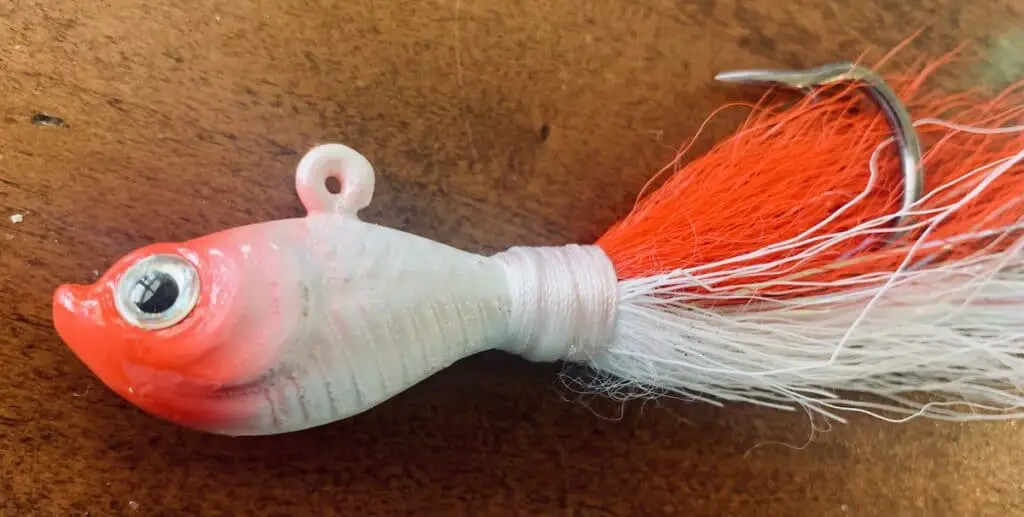
The hooks on these jigs are strong wire Gamakatsu hooks. These are hooks that I trust won’t bend when I hook into a large grouper. I usually go for red and white, but I have friends who swear by the chartreuse color. Whichever your preference, pick one up and try it the next time you’re bottom fishing over a wreck.
Sometimes I’ll tip the jig with a small piece of Fishbites. I live in Florida so I have to be careful not to put natural bait on a J hook when targeting reef species. Honestly, Fishbites is so easy to deal with and so effective for me that I’d rather use that than cut bait sometimes anyway.
To dive into more about the hook regulation I mentioned, read my article on Bottom Fishing Hooks.
Use Bottom Sweeper Jigs Near Wrecks
Usually when I think of bottom fishing in the ocean, I’m thinking of grouper, snapper, hogfish, or triggerfish near deep reefs, wrecks, or drop offs. Sometimes you’ll come across a bunch of sheepshead when fishing an old wreck.
A few bottom sweeper jigs are great to keep in your tacklebox offshore for those times when you’re bottom fishing and start pulling up sheepshead. Sheepshead are good eating, so it's a fun species to fill up the boat.
These bottom sweeper jigs by Insomniac Outdoors are designed to stand up when placed on a surface. Its expertly designed to avoid getting stuck in wreck and reef structures. The weight options are heavy enough to reach the bottom and there’s a variety of colors to choose from. The darker the water, the darker the color I’ll use, although I’ve been known to drop a pink one “just because”.
Whenever I tip these with small crabs such as fiddler crabs, they get struck almost immediately. I recommend picking up a 1 oz, 2 oz, and a 3 oz jig and keeping in your tackle box you plan to bring offshore. The proper weight depends on the water depth and the current, so its always good to have options. Even if it feels like you’re bringing along too much tackle, your tackle sure isn’t doing you any good sitting in the garage!
Once you’re over the structure, drop these jigs to the bottom, jig your rod up a bit, repeat if you need to and it won’t be long until you feel a bite. Sheepshead have teeth, but don’t worry, they rarely nibble on fingers.
Slow Pitch Jigs Are Deadly for Grouper
Bottom feeders love to strike slow pitch jigs. Even when traditional bottom fishing bait rigs (see my article here for details) are striking out, slow pitch jigs will put fish in the boat. To do this technique best, you’ll need a specialized rod and reel setup, but you can always try it with whatever setup you have.
The simplest form of slow pitch jig consists of a wide and flat body shaped similarly to a leaf. One side is flat and one side has a contoured v shape. The lure is weighted in the center to help it fall horizontally. The lure is rigged with at least one “assist hook” which is usually a J hook connected to the top eyelet solid ring, split ring, and a heavy cord.
The technique is done by first allowing the jig to fall in a controlled freespool all the way to the bottom, jigging it up a few feet, and then dropping it again. The strikes occur on the fall so the more time the lure spends in the falling position, the better. These jigs will lay horizontally as they fall and wobble.
There are other slow jigs that are worked the same way but have a slightly different action. Some have a more erratic fall, and some swing. Read on to learn about some of the best slow pitch jigs for bottom fishing offshore.
Shimano Butterfly Flat Fall Jig
The Shimano Butterfly Flat Fall jig is my favorite slow jig. The quality of Shimano’s collection of butterfly jigs is unmatched. The 3D eyes and tough paint job will make this lure stay in tip top shape after several fishing trips.
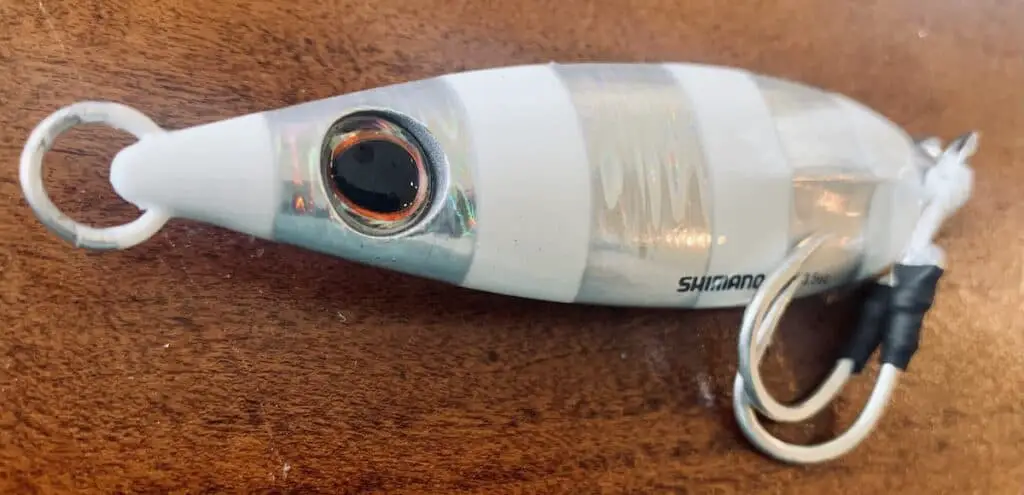
The jig has a v shaped hull on one side and is mostly flat on the other. It slowly falls to the bottom, parallel to the bottom and wobbling like a dying baitfish. It provokes a reactionary bite from anything it encounters through the water column and is especially deadly on grouper.
Pick one up in chartreuse or pink and blue in the 130 gram size for $16.50. This price is on the higher end, but this lure will no doubt last a long time, especially if you take care to add a short wire leader when you see barracudas around.
Nomad Buffalo Jig
Nomad Design comes out with some truly great quality lures. The Buffalo jig is no exception. Its center-weighted so it’s designed to turn completely horizontal and wobble as it falls. Its action is similar to that of the Shimano Flat Fall jig. Unique to this jig, an assist hook comes pre-rigged at the rear eyelet. This can secure a hookset even if the fish doesn’t strike at the midpoint of the lure. I like to use this one when it seems like the fish are narrowly escaping getting hooked.
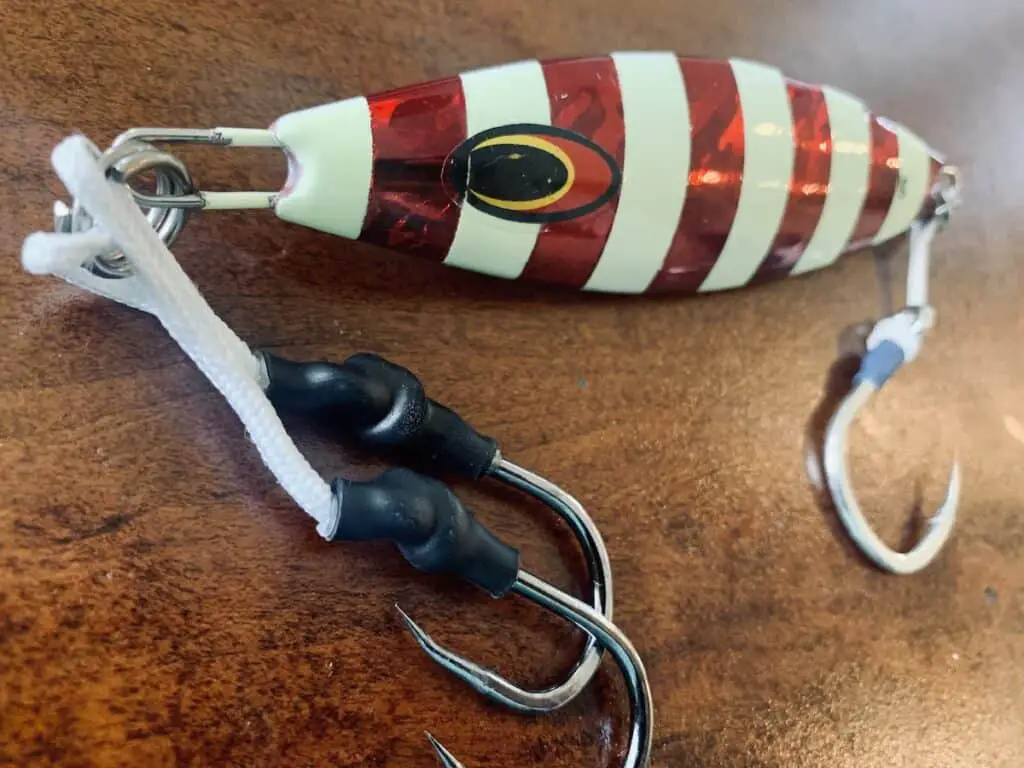
The Buffalo Jig is an affordable $13 for a 120 gram jig and comes in a variety of colors. I picked up the Crimson Tide color to help build the variety in my jig collection. The hooks on 5X strength BKK hooks which should be tough enough to handle the biggest grouper you can find.
Shimano Butterfly Flat Side Jig
The Shimano Butterfly Flat Side Jig is a slightly different style of slow pitch jig. On this jig, the weight mostly stays towards the rear center and the rear is curved. This allows the lure to almost swing on the way down.
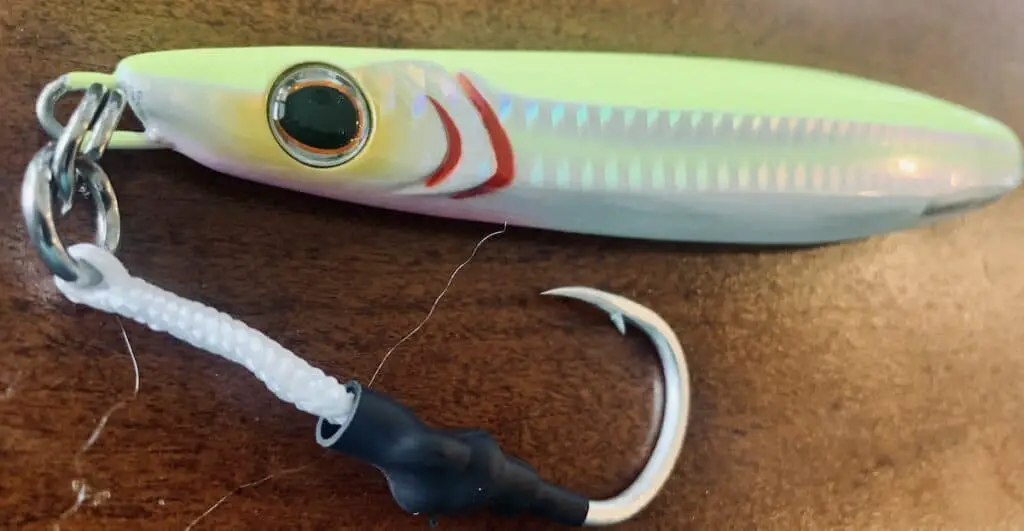
It also has different eye styles on each side. They’re both high quality 3D eyes, but one is located more towards the center of the jig and one is located far more forward. This affects the way the hook falls beside the lure and gives it 2 different presentations, depending on the which side of the jig the hook falls on.
This jig is a pricey $17.50 for the 140 gram option, but is a critical jig to have when nothing else is getting bit. I never head out on a fishing trip without this one.
OTI Slow Pitch Jig
For anyone trying to build up a collection of slow pitch jigs on a budget, the OTI Slow Pitch Jig is for you. The 135 gram jig costs only $12 and comes pre-rigged with one assist hook on the top eyelet with added flash. The hook on the top eyelet hooks the fish when the majority of the rig is bit. The jig is keel-weighted, making it wobble erratically as it falls.
The sharp angles of this jig give it a unique action on the fall and the retrieve. Try this one in the chartreuse color the next time you go out. The only downside I see in this jig is the quality of the eyes. They aren’t painted, but rather are stickers. I’m pretty sure this will wear off and I’ll be painting a new on eventually.
OTI slow pitch jigs are very affordable. I picked mine up in a slow jig set with a bag and ended up getting several jigs and a nice storage bag for about a hundred bucks. Check out the slow jigging kit I got, here.
At Shallow Reefs, Try a Paddletail and Jig Head
Mutton and mangrove snapper can be caught nearshore in shallower waters with baited rigs or small jigs. Whenever I’m doing this kind of bottom fishing, I tend to reach for the Z-man swimbaits paired with a jig head.
Z-man paddletails are some of the most durable paddletails I use. They’re my go-to and I’ve recently been working with the scented ones. I like that the Z-man scented jerk shadz come scented so I don’t have to separately apply pro-cure to them.
Pair the 5 inch Z-man scented jerk shad with a 4/0 hook, 1/2 oz jig for waters less than 60 feet deep and you’ve got a combination that’ll lure a snapper in and secure the hook. The jig has an extra strong and sharp Mustad Ultrapoint hook that’ll easily pierce through a snapper’s lip.
The eyelet is on the top of the jig head so the swimbait will stay horizontal in the water and maintain a natural presentation. It also has bait holder threads to prevent the swimbait from falling off. This jig combination is sure to catch the attention of nearshore snapper and is a very economical price point. The jig head will last a long time and costs $8 and a pack of 5 paddletails runs about $5.
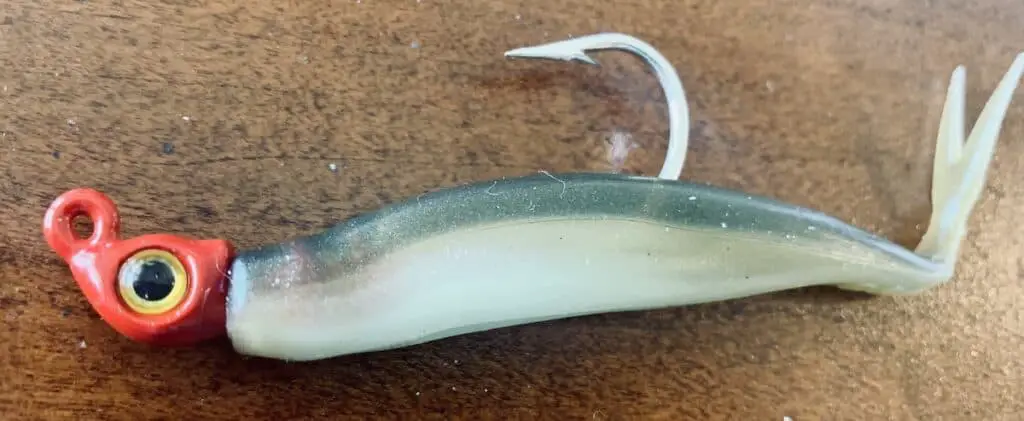
The color options are nearly endless. I counted up to 18 color varieties. As a safe bet, I’d start with a whitish one like Pearl, a gold one like Slam Shady, and a grayish one like Shiner. The jig head is unpainted, which rarely matters because of its relatively small size.
I hope this article was a helpful resource in learning how to gear up for bottom fishing with lures. If you’re up for trying out live bait or cut bait, learn about bottom fishing with bait in my Best Bait for Bottom Fishing article.
If you need to learn more about how to find bottom fish, or bottom fishing techniques, read my article Bottom Fishing: Everything You Need to Know.
Tight lines, y’all!
Recent Posts
Fat Cow Jig Strips: The Ultimate Bucktail Jig Upgrade for Surf Fishing
As discussed in my previous article, "Surf Fishing with Bucktail Jigs: Ultimate Guide for Beach Anglers," bucktail jigs are a staple in any surf angler's tackle box, offering a versatile way to catch...
In my previous article, "Surf Fishing with Bucktail Jigs: Ultimate Guide for Beach Anglers," I introduced you to the bucktail jig and discussed how versatile of a lure it is for catching a wide range...

